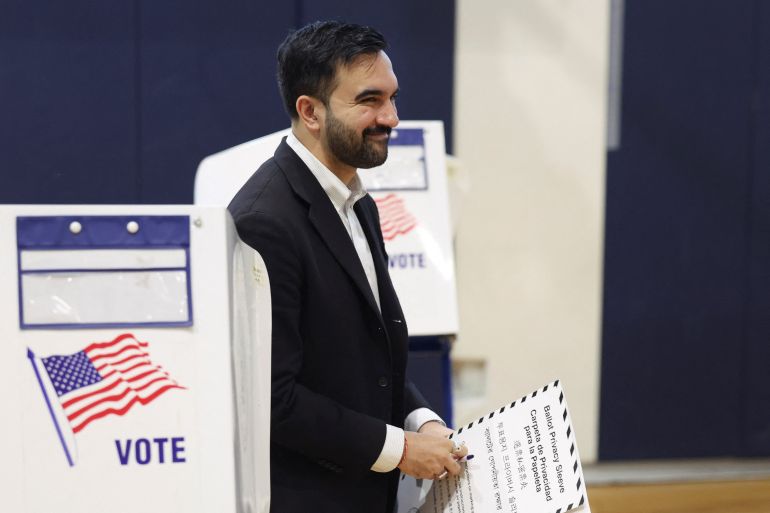Fact check: Was listing candidates twice on NYC ballot a scam?
Elon Musk criticised New York’s election system, citing fusion voting, duplicate candidates and ID concerns.

By Louis Jacobson | Politifact
Published On 5 Nov 20255 Nov 2025
Save
Elon Musk, the owner of social media platform X, criticised the legitimacy of New York City’s election system as voters prepared to head to the polls on Tuesday.
Musk shared a photograph of the city’s ballot on election day. “The New York City ballot form is a scam! No ID is required. Other mayoral candidates appear twice. (Andrew) Cuomo’s name is last in bottom right,” wrote Musk, who supported Cuomo over Democratic frontrunner Zohran Mamdani and Republican candidate Curtis Sliwa. Other X users made similar points in other posts.
Recommended Stories
list of 4 itemsend of list
New York does not require voters to present IDs at their polling place on election day, beyond first-time voters who were unable to present their IDs at the time they registered. For all other voters, poll workers confirm identity by matching their signature to official records. People are required to present ID when they register to vote.
As for Cuomo’s ballot placement, the former New York governor lost the Democratic primary and created his own independent party to allow him to run in the general election. According to election rules, that meant the placement for Cuomo and his new party was further down the ballot than longer-established parties.
What about candidates appearing twice? There is nothing fishy about that: It is part of New York’s long tradition of fusion voting, in which multiple parties can nominate the same candidate.
Having a candidate appear on the ballot twice is “not a scam at all”, said Jerry H Goldfeder, senior counsel at the law firm Cozen O’Connor. “New York has had fusion voting for many, many years.”
Advertisement
How does fusion voting work?
If a candidate receives more than one party nomination, voters must choose not only the candidate they prefer but also the party they want those votes to count for.
In the 2025 mayoral election, Mamdani and one of his opponents, Sliwa, secured nominations from two parties, so they are listed twice on the ballot.
Mamdani won nominations from the Democratic Party and the left-wing Working Families Party. On election day, Mamdani said he voted for himself on the Working Families Party line.
Sliwa won the nomination of the Republican Party and a party he created, called the Protect Animals Party. Sliwa has attracted notice for having 16 cats in his 320-square-foot studio apartment, and he has made animal welfare a key campaign issue.
Any votes for a candidate, regardless of the party line the vote is cast under, count towards that candidate’s total. “Although candidates may appear on more than one party’s line, voters can only vote for them once,” said Julia Sass Rubin, a Rutgers University public policy professor.
So why would voters support a prominent candidate on a minor-party line?
They might want to send a message about the importance of that party’s positions. They also might want to ensure that the smaller party continues to win enough votes to secure a ballot spot in future elections.
By allowing cross-party alliances, a fusion system allows smaller parties to be more than just a “wasted vote” or a self-defeating “spoiler”, said Dan Cantor, who cofounded the Working Families Party and now heads the Center for Ballot Freedom, which supports fusion voting.
“It allows voters the ability to vote their values and send a message to the candidate that he or she should be attentive to the minor party’s concerns,” Cantor said.
Fusion voting’s long history
Fusion voting dates to the 19th century, but only New York and Connecticut allow the practice today.
Historically, cross-nominations were used to elevate issues, including the abolition of slavery and enhanced political representation into the mainstream, wrote three legal experts for the American Bar Association in 2024.
In the close 1960 presidential election, New York’s 45 electoral votes were crucial. While Richard Nixon received more Republican votes than John F Kennedy received Democratic votes, “Kennedy’s 6 percent support on the Liberal Party line delivered him the state and the White House,” the authors wrote. Franklin D Roosevelt and Ronald Reagan also won New York by fusing with minor parties.
Advertisement
Tabatha Abu El-Haj, one of the authors of the American Bar Association paper, said there is an irony in Musk’s criticism. “Back when Elon Musk threw out the notion of forming a third-party, many commentators noted the only way that party could actually influence the direction of the Republican Party would be if it operated as a fusion party.”
Our ruling
Musk wrote, “The New York City ballot form is a scam” because “mayoral candidates appear twice”.
Mamdani and Sliwa are on the mayoral ballot twice because two separate parties made them their nominees. This is how fusion voting works, and how it has operated in New York since the 19th century.
We rate the statement False.
Jill Terreri Ramos contributed to this report.
